India is one of the great economic success stories; the country has enjoyed rapid growth and development over recent years. Today, it is the world’s fourth-largest economy and according to the IMF, the country is expected to realize 7.5% GDP in 2016-2017. With 1.2 billion people, India has the second-biggest population in the world.
India has undergone some significant changes in recent years in terms of better life expectancy, vastly improved literacy and health conditions, and population shifts. The urban middle class is growing rapidly and could account for 41% of the total population by 2025, says Ash Kuchel, Group President, EU/APAC, Publicis Healthcare Communications Group.
A Rosy Industry Picture
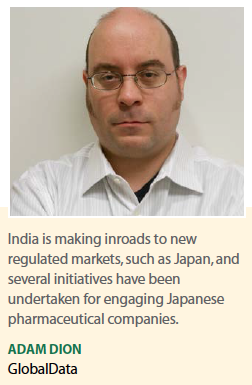 India has a fast growing and dynamic pharmaceutical industry that is represented by both Indian as well as multinational pharmaceutical companies, according to Naz Haji, senior VP and head, India, Quintiles.
India has a fast growing and dynamic pharmaceutical industry that is represented by both Indian as well as multinational pharmaceutical companies, according to Naz Haji, senior VP and head, India, Quintiles.
Various industry reports indicate that the pharmaceutical market has been growing between 13% and 14% over the past five or six years, a massive increase from the 9% compounded annual growth rate between 2000 and 2005, according to a McKinsey report, India Pharma 2020: Propelling Access and Acceptance, Realising True Potential.
Today the Indian pharmaceutical market is the third largest in terms of volume and 13th in terms of value, according to a report from Equity Master. By 2020, the Indian pharmaceutical market is expected to grow to $55 billion, according to McKinsey.
The Indian pharmaceutical industry is being buoyed by a number of factors, Mr. Kuchel says. These include rising income levels, an enhanced medical infrastructure, an increasing burden of chronic diseases, the development of newer molecules, greater insurance coverage, and a rising use of products in specialty and super-specialty disciplines.
“The development of newer biologics and vaccines would further trigger growth," he says.
Market fragmentation is one of the complexities facing the Indian market, say experts at Sorento Healthcare Communications, a member of The Bloc’s global network, Indigenus.
“The market share by the leading players is low," says Swati Sivaram, head of knowledge planning of Sorento. “For example, Cipla’s market share at the time it was the market leader — before consolidation among the top players — hovered around 5%, which is an indication of the level of market fragmentation."
Mr. Haji says the Indian pharmaceutical industry has reached an interesting point.
“The growing patient population, increasing public and private investments in healthcare and healthcare infrastructure, wider health insurance coverage, and rising incomes are driving domestic demand and growth," he says.
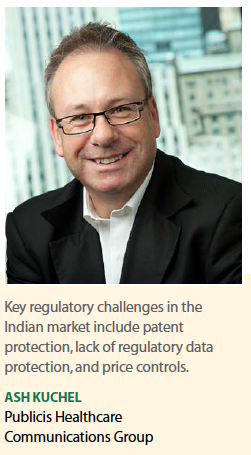 Many pharmaceutical companies that started as India-based generics manufacturers are expanding their footprint and becoming global through partnerships and organic expansion, says Chitra Lele, Ph.D., chief scientific officer at Sciformix.
Many pharmaceutical companies that started as India-based generics manufacturers are expanding their footprint and becoming global through partnerships and organic expansion, says Chitra Lele, Ph.D., chief scientific officer at Sciformix.
One country where Indian pharmaceutical companies are making inroads is Japan, says Adam Dion, senior industry analyst at GlobalData.
“Several initiatives, namely the Brand India Pharma campaign, have been undertaken by the industry to engage Japanese pharmaceutical companies, including contract manufacturing of advanced intermediates for drugs under clinical development," Mr. Dion says, noting that there has been an upturn in business development in Japan from Indian drug companies. In November 2015, Sun Pharmaceutical Industries purchased the Japan-branded portfolio from Novartis for around $400 million.
Mr. Kuchel says the generics market reached $100 billion in 2010. Generics growth is three times higher than the overall growth of drugs, and India’s share in the generics market is almost 35%.
While the generic drug market remains the fuel that powers the country’s pharmaceutical market, Mr. Dion says manufacturing issues, lack of oversight of clinical trials, and compulsory licensing could dampen growth.
Mr. Haji adds that while Indian generic companies are growing in strength in overseas markets, a shift in the portfolio mix of Indian companies is emerging, with companies starting to gain a foothold in biosimilars and to a lesser extent in biologics and patented products.
McKinsey & Company estimates the biologics market to grow to US$3 billion by 2020 and even further if India can take what it describes as bold measures related to physician education and confidence.
Another significant industry trend in India is the growth of outsourcing to Indian companies. Dr. Lele says outsourcing of clinical trial services to India started in the early part of the last decade and included patient recruitment and all data, analysis, and reporting related activities for global clinical trials conducted primarily by large pharmaceutical companies. Over the last seven or eight years, pharmacovigilance outsourcing to India by all companies, large and small, has grown very rapidly.
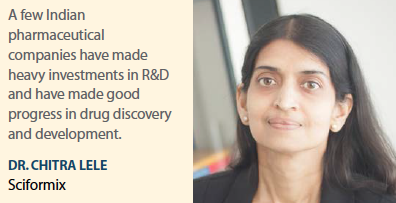 “Over the years, the type of work being outsourced to India in the above areas has changed, fluctuated, and evolved," Dr. Lele says. “For example, for the past several years, due to the regulatory environment in the country, placement of global clinical trials in India has reduced drastically. But regulatory writing, programming, and pharmacovigilance are the areas that have seen growth."
“Over the years, the type of work being outsourced to India in the above areas has changed, fluctuated, and evolved," Dr. Lele says. “For example, for the past several years, due to the regulatory environment in the country, placement of global clinical trials in India has reduced drastically. But regulatory writing, programming, and pharmacovigilance are the areas that have seen growth."
Global Presence
A growing number of multinational pharmaceutical companies are entering the Indian market although domestic companies continue to rule, says Sreedevi Yallamrazu, business manager of CubeX, a division of Sorento.
This has been achieved through global consolidations, acquisitions, and direct presence.
“Companies such as Boehringer Ingelheim have relaunched brands such as Buscopan and Dulcolax with local companies, post termination of licensing agreements," Ms. Yallamrazu says.
According to Gauri Pathak, general manager, India, for Kantar Health, global companies have a large opportunity in India, which has a huge patient pool.
“There is a growing middle class; people are experiencing wealth and luxuries that previous generations may not have seen," she says. “While there are challenges in terms of pricing and access, innovative partnership options with local players can help global companies get better access and also address the potential threat of copying. Besides that, innovative pricing and access strategies can help make the product more affordable."
Sourcing of drugs and active pharmaceutical ingredients from India continues to be a significant opportunity for global companies, Dr. Lele says.
“Sourcing of services from India is the other big opportunity given the vast talent pool in India with education in science and technology," she says.
In terms of which companies are gaining the biggest foothold in the Indian market, McKinsey notes that four of the top 10 players are recent entrants to the market.
Mr. Kuchel says the number of mergers and acquisitions has been increasing, noting that in 2014 there was a 44.5% rise in M&A compared with 2013, as a result of several investments and joint ventures that have fueled the growth of multinational giants in India.
“The opportunities for MNCs lie in the areas of CROs, high-end products, and clinical trials owing to the availability of skilled doctors and other medical and paramedical personnel," he adds.
In terms of commercial potential of the market, India still lags behind some other emerging market countries, Dr. Lele says. But due to its large population, India is an important market for global companies from a sales and marketing perspective.
Opportunities for R&D
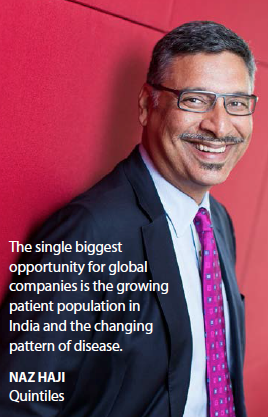 The spending pattern of Indian pharmaceutical companies has changed and today it is estimated that the industry spends around 18% of revenue on R&D.
The spending pattern of Indian pharmaceutical companies has changed and today it is estimated that the industry spends around 18% of revenue on R&D.
“As innovation assumes more importance across domestic companies, as well as multinational companies, investment in R&D is likely to be sustained or may even grow much higher," Ms. Yallamrazu says.
Initiatives aimed at strengthening R&D in pharmaceuticals have been introduced by the Indian government, including fiscal incentives for in-house R&D units, streamlining of procedures for the development of new drug molecules, clinical research, and new drug delivery systems and more recently tax incentives for patent development and registration in India, Mr. Haji says.
Recently the government proposed cuts to the weighted tax reduction on R&D expenses from 200% to 150%, which disappointed many pharma companies.
At the same time, however, the government did announce other tax incentives, such as a 10% rate of tax on income from worldwide exploitation of patents developed and registered in India.
Patient Dynamics
India has the largest disease burden in the world, Mr. Haji says, and faces what the government calls the triple burden of diseases, which include communicable diseases, emerging non-communicable diseases related to lifestyle, and emerging infectious diseases.
“The growth in lifestyle and non-communicable diseases also means that our disease burden is aligned with the new drug development focus of global biopharma companies," he says, adding that another big opportunity for global companies is vaccines.
It is estimated that more than 65% of the Indian population does not have access to quality healthcare, Ms. Sivaram says.
In order to increase access to essential medicines, the government introduced a policy to provide generic drugs free in all public healthcare facilities, Mr. Dion says.
“The provisions of the policy state that 348 essential drugs and their various formulations will be offered to all patients in public hospitals," he says. “It is expected to provide free medicine to 52% of the population by the end of 2017, for which, expenditure will amount to about $5.4 billion."
Mr. Kuchel notes, however, that more interventions are needed to reach those in rural areas. This need is underscored by a recent study that found the availability of essential medicines in two North Indian states to be 51.1% (Haryana) and 45.2% (Punjab).
A study by IMS Health has claimed that access has not improved despite the price cuts, though the government claims that consumers have benefited to the extent of US$440 million, Ms. Sivaram says.
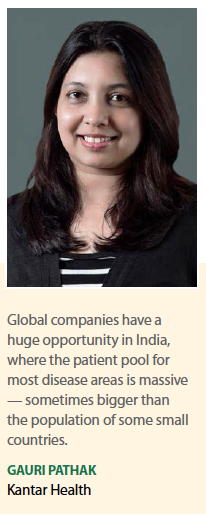 At the same time there is a growing population of patients older than 60 due to affluence, better health facilities, and general health awareness.
At the same time there is a growing population of patients older than 60 due to affluence, better health facilities, and general health awareness.
“An aging population will need support for chronic therapies, fostering adherence and compliance," Mr. Kuchel says. “There is also a steady rise of serious diseases, such as diabetes and heart disease, which provide opportunities for marketers to introduce new health solutions into the market."
As with other markets, Indian consumers are taking an increasing interest in their own health, Mr. Kuchel notes, which creates an opportunity for global companies to come in and reinforce patient-centric care.
According to Ms. Yallamrazu, pharma companies are beginning to actively consider consumer-focused marketing to drive volumes.
“Glenmark and Cipla are some of the new entrants into the Indian OTC market," she says. “Cipla has even hived off its consumer division into a separate subsidiary with a financial partner on board, hiring talent with consumer marketing experience to ensure that its second attempt at consumer marketing is robust, operationally as well as financially."
Ms. Yallamrazu says Cipla had initially entered the consumer domain in 2007 with i-pill, creating the market for emergency contraceptive pills. Cipla later exited by selling i-pill to Piramal in 2010 as it wanted to focus on prescription drugs.
The Clinical Environment
For many years, the Indian clinical trials market enjoyed tremendous growth thanks to large and accessible patient pools, and low-cost labor and R&D, Mr. Dion says.
The clinical trial industry faced a major drawback in 2013 when the Supreme Court revoked the right of the Central Drugs Standard Control Organization (CDSCO), the national regulatory body for Indian pharmaceuticals and medical devices, to approve clinical trials in the country, Dr. Lele notes.
This was enacted due to the increasing number of patient deaths during clinical trials in the country, she says, noting that around 2,644 individuals who had signed up for the trials of 475 new drugs died between 2005 and 2012.
“The Supreme Court also banned clinical trials on 162 drugs in India and asked the authorities to strengthen approvals and monitoring for clinical trials in India," she says.
Mr. Dion says India’s Ministry of Health is pushing the requirement of studies being conducted in a GMP-compliant facility that is on file with regulators and subject to random inspections, along with patients testifying to their informed consent via video camera before undergoing treatment.
“Indian regulators have now adopted a consultative approach, and are committed to creating a more robust regulatory environment for clinical trials in India with patient safety at its core," Mr. Haji says. “Investments are also being made to strengthen the regulatory infrastructure, including training of regulatory personnel, leading to shorter timelines for clinical trial approvals. Balanced compensation guidelines are also in place. We now anticipate acceleration on the remaining regulatory improvements, which will instill more confidence in global companies wanting to do business in India."
However, while Dr. Lele agrees that recent policies and actions have improved the overall outlook for the clinical trial industry, she says it will take some time before there is a marked increase in the number of clinical trials recruiting in India since most sponsors would like to wait and watch for some time before they consider investigator sites in India.
Mr. Kuchel notes that today India carries out a mere 1.4% of global clinical research.
Mr. Dion adds that pharmaceutical companies have often complained about the slow pace of application approvals, and now with the loss of patent protection for some of their biggest blockbuster drugs, pharma companies have already moved to other countries, such as China, for conducting their trials cheaper and quicker.
Dr. Lele adds that numerous factors make India an attractive destination for global clinical trials: English-speaking healthcare professionals; expert clinicians, including returning, Western-trained physicians; economic growth; access to world-class technologies; information technology and data management infrastructure; access to large, treatment-naïve and ethnically diverse patient populations with diseases of public health relevance; competitive operational costs; and internationally harmonized regulations. (See Bonus Content in Digital Edition for more information.)
Regulatory Challenges
Recent policy and actions have improved the outlook for the industry, Dr. Lele says, pointing to guidelines on compensation for patients; the push for IT-enabled systems for clinical trial approval, enforcement, and monitoring; and ensuring the patient is aware of all of the side effects of the trial before giving written consent.
In recent years, regulatory authorities have dealt a series of blows to the Indian pharmaceutical industry, including expanding the list of essential medicines, price caps, and the more recent ban on fixed dose combinations, Ms. Sivaram says.
According to Mr. Kuchel, the regulatory challenges in the Indian market include patent protection, lack of regulatory data protection and government price controls.
“On top of these, there exist some major shortcomings in the administrative structure of the regulatory mechanisms in India, such as limited qualified resources and infrastructure, such as laboratories," he says.
Pricing controls are another challenge, according to Ms. Pathak, who notes that the National Pharmaceutical Pricing Authority, which monitors prices of medicines in the country, has proposed changes to the existing Drug Price Control Order, seeking provisions to impose a fine on those violating pricing norms.
“The regulator is of the view that there is need for tougher laws on pricing of pharmaceutical products," she says.
Mr. Dion singles out the new intellectual property (IP) rules in the European Union as an issue facing Indian pharmaceutical companies. The EU has adopted new regulations that empower EU countries to impound Indian-made drugs that are shipped via the EU to developing countries, such as those in Africa, ultimately negatively impacting drug exports, he says.
The new regulations were the result of several EU nations seizing and suspending the sale of 700 generic drugs tested by GVK Biosciences because of quality control worries. GVK Biosciences is an Indian-based contractor found to have manipulated bio-equivalency data, back in 2015.
“This event caused India and the EU to break off trade discussions that are only now getting back on track with the GVK issue resolved," Mr. Dion says. “However, EU nations are maintaining their stance on stricter regulations which, has Indian drugmakers worried about potential impact on sales."
In addition, pharmaceutical companies selling drugs in India see compulsory licensing as a hindrance to their patented products, Mr. Dion adds.
“The government granted a license to Natco Pharma for manufacturing and selling a low-cost generic version of sorafenib — a patented drug manufactured by Bayer," he says. “Natco was given the license because Bayer was restricting accessibility to the drug. Drug companies are concerned if compulsory licensing continues, it will drive business to other markets that honor patent/IP exclusivity." (PV)



















